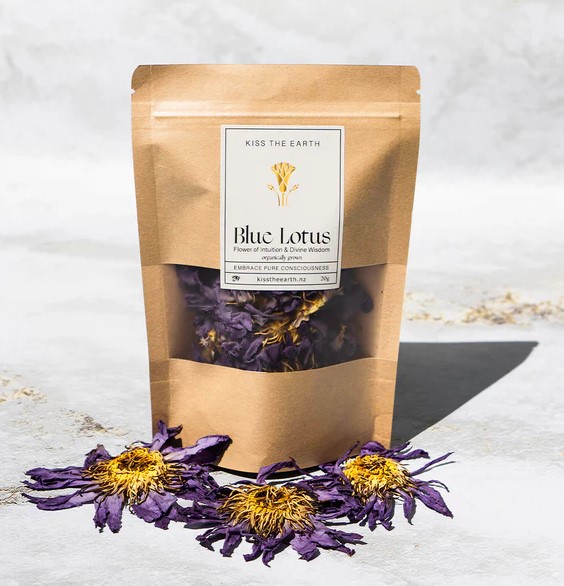BOURSESSENEGAL – Blue lotus, also known as Nymphaea caerulea, has captured the attention of many for its beauty and intriguing properties. This enchanting flower holds a significant place in history, culture, and wellness practices. In this guide, we will delve into the various aspects of blue lotus, including its history, benefits, uses, and how you can incorporate it into your life. Let’s uncover the secrets of this remarkable plant!
What Is Blue Lotus?
A Brief Introduction to the Plant
Blue lotus is a water lily native to Egypt and parts of East Africa. Known for its striking blue petals and yellow stamens, this flower thrives in freshwater environments. Beyond its aesthetic appeal, blue lotus has long been associated with spiritual significance and medicinal uses.
Historical Significance
The ancient Egyptians revered blue lotus for its psychoactive properties and used it in religious rituals. Often depicted in art and hieroglyphs, the flower symbolized rebirth and the sun. The Egyptians believed that blue lotus could connect them with the divine, making it a crucial part of their culture.
Benefits of Blue Lotus
1. Natural Relaxant
One of the most celebrated benefits of blue lotus is its calming effect. Many people use it to alleviate stress and anxiety. The compounds in blue lotus can promote relaxation and enhance mood, making it an excellent choice for those looking to unwind.
How It Works
Blue lotus contains alkaloids that interact with the body’s receptors, leading to feelings of tranquility. Users often report a sense of euphoria, allowing for a more peaceful state of mind.
2. Aphrodisiac Properties
Historically, blue has been considered an aphrodisiac. Many cultures believed that it could enhance sexual desire and performance.
Modern Use
Today, people often incorporate blue into herbal blends aimed at boosting libido. Whether through teas or tinctures, many find that it enhances intimacy and connection.
3. Pain Relief
Another significant benefit of blue lies in its potential for pain relief. Some users turn to this flower for relief from headaches, menstrual cramps, and other forms of discomfort.
Mechanism of Action
The anti-inflammatory properties in blue can help reduce pain sensations. By targeting inflammation, this natural remedy provides an alternative to conventional pain medications.
4. Enhanced Sleep Quality
Struggling with sleep? Blue may hold the key to better rest. Many find that consuming this flower before bedtime helps them fall asleep faster and enjoy deeper sleep.
How to Use for Sleep
A calming herbal tea made from blue can create a soothing bedtime ritual. This natural remedy promotes relaxation and prepares the body for a good night’s rest.
How to Use Blue Lotus
1. Herbal Teas
One of the most popular ways to consume blue is through herbal teas. Brewing the dried flowers in hot water extracts their beneficial compounds, providing a calming beverage.
Brewing Instructions
To make blue lotus tea:
- Boil water.
- Add 1 to 2 teaspoons of dried blue petals to the water.
- Steep for 10 to 15 minutes.
- Strain and enjoy.
2. Tinctures
Blue tinctures offer a concentrated form of the flower’s benefits. These liquid extracts can be added to water, smoothies, or other beverages for easy consumption.
How to Use Tinctures
Typically, a few drops of tincture will suffice. Start with a small dose and adjust based on your needs.
3. Essential Oils
Blue essential oil is another popular option, known for its aromatic properties. Many use it in aromatherapy to promote relaxation and elevate mood.
Diffusing for Benefits
Add a few drops of blue essential oil to a diffuser. Inhale the soothing scent to experience its calming effects.
Potential Side Effects and Considerations
While blue offers numerous benefits, it’s essential to use it responsibly. Most people tolerate this plant well, but some may experience mild side effects such as dizziness or headaches.
Who Should Avoid Blue Lotus
Individuals who are pregnant, breastfeeding, or taking certain medications should consult a healthcare professional before using blue . This ensures safety and avoids potential interactions.
Cultural and Spiritual Uses
Blue Lotus in Ancient Egypt
As mentioned earlier, blue played a significant role in ancient Egyptian culture. Its psychoactive properties made it a key ingredient in rituals aimed at achieving higher states of consciousness.
Rituals and Offerings
Priests often used blue in ceremonies dedicated to deities, believing it could facilitate communication with the divine. Offerings of the flower were common in temples, showcasing its importance.
Modern Spiritual Practices
Today, blue continues to be used in various spiritual practices. Many people incorporate it into meditation or yoga sessions, using its calming properties to enhance focus and mindfulness.
Where to Find Blue Lotus
If you’re interested in trying blue , you can find it in various forms at health food stores, online retailers, or specialty herbal shops. Look for high-quality, organic products to ensure purity and effectiveness.
Forms of Blue Lotus Available
You can choose from dried flowers, tinctures, essential oils, and capsules. Select the form that best suits your lifestyle and preferences.
Conclusion: Embrace the Benefits of Blue Lotus
Blue stands out as a remarkable plant with a rich history and numerous benefits. Whether you seek relaxation, enhanced intimacy, or natural pain relief, this flower offers a versatile solution.
Start Your Journey
Consider incorporating blue into your wellness routine. Experiment with teas, tinctures, or essential oils to find what works best for you. By embracing this enchanting flower, you can unlock its potential for improving your overall well-being.
Connect with Nature
As you explore the world of blue , remember to connect with nature. Each time you enjoy its calming properties, you partake in a tradition that spans thousands of years, enriching your mind, body, and spirit.
REFERENCE : sinaga119



